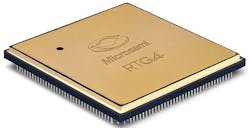ALISO VIEJO, Calif., 6 May 2015. Microsemi Corp. in Aliso Viejo, Calif., is introducing the RTG4 radiation-tolerant high-speed field-programmable gate array (FPGA) family for manned spacecraft and satellites.
The RTG4's reprogrammable flash technology offers immunity to radiation-induced configuration upsets in radiation environments, requiring no configuration scrubbing. RTG4 supports space and high-altitude aviation applications requiring as many as 150,000 logic elements and as much as 300 MHz of system performance.
Typical uses for RTG4 include remote sensing space payloads like radar, imaging and spectrometry in civilian, scientific and commercial applications for weather forecasting and climate research, land use, astronomy and astrophysics, planetary exploration, and Earth sciences.
Other applications include mobile satellite services (MSS) communication satellites, as well as high altitude aviation, medical electronics, and civilian nuclear power plant control. Such applications historically have used expensive radiation-hardened ASICs.
The FPGAs has as many as 150,000 logic elements; each includes a four-input combinatorial look-up table (LUT4) and a flip-flop with built-in single event upset (SEU) and single event transient (SET) mitigation. The devices also have system performance to 300 MHz.
Other features include 24 serial transceivers, with operation from 1 o 3.125 gigabits per second; 16 SEU- and SET-protected SpaceWire clock and data recovery circuits; 462 SEU- and SET-protected multiply-accumulate mathblocks; more than 5 megabits of on-board SEU-protected SRAM; ingle event latch-up (SEL) and configuration memory upset immunity; and total ionizing dose (TID) beyond 100 kilorads.
For more information contact Microsemi online at www.microsemi.com.



